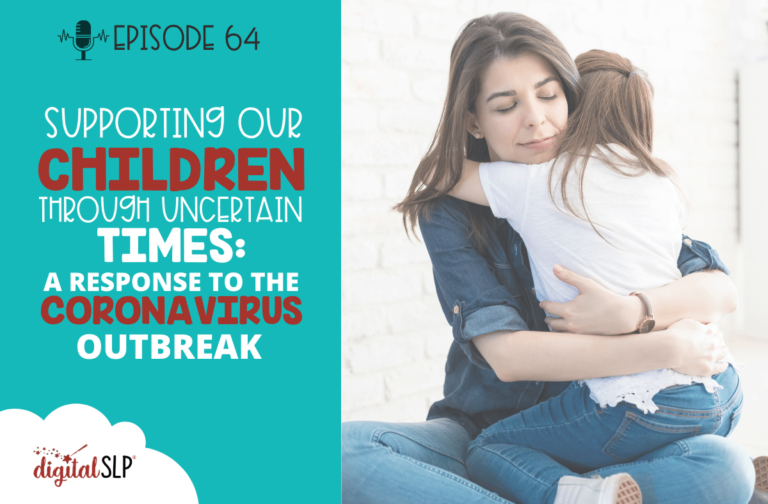In today’s episode, I’ll be discussing stridency deletion and how to address it in speech therapy. Stridency deletion is one of the phonological patterns often seen in highly unintelligible children.
- https://blogs.umass.edu/eba/files/2012/01/201Spring-Consonant-Features-Guide1.pdf
- https://blogs.umass.edu/eba/files/2012/01/201Spring-IPA-features.pdf
- https://www.clarityforcommunication.com/slp-qa *This is a great resource from Teresa Farnham. It has a very user-friendly FAQ section about the complexity approach.
- http://classlab.cci.fsu.edu
- Friberg, J. C., & Lund, K. K. (2010). The effects of supplemental joint storybook reading on preschool students’ use of strident sounds: A preliminary investigation. Contemporary Issues in Communication Science and Disorders, 38, 174–180.
- http://www.glottopedia.org/index.php/Strident
- Hodson, B. W. (2011). Enhancing phonological patterns of young children with highly unintelligible speech. The ASHA Leader, 16(4), 16–19. https://doi.org/10.1044/leader.FTR2.16042011.16
- Hodson, B. W. (2007). Evaluating and enhancing children’s phonological systems: Research & theory to practice. Greenville, SC: Thinking Publications.
- Hodson, B. W., & Paden, E. P. (1981). Phonological processes which characterize unintelligible and intelligible speech in early childhood. Journal of Speech and Hearing Disorders, 46(4), 369–373. https://doi.org/10.1044/jshd.4604.369
- Fabiano-Smith, L. (2019). Standardized tests and the diagnosis of speech sound disorders.
- Perspectives of the ASHA Special Interest Groups, 4(1), 58–66. https://doi.org/10.1044/2018_PERS-SIG1-2018-0018
- https://kuscholarworks.ku.edu/handle/1808/24767
- https://www.proedinc.com/Downloads/31089Intro.pdf
- https://scipapp.com/
- https://www.speech-language-therapy.com/pdf/alpha6.pdf
- https://spgtherapy.com/wp-content/uploads/2019/04/Phonological-Processes.pdf
- Storkel, H. L. (2022). Minimal, maximal, or multiple: Which contrastive intervention approach to use with children with speech sound disorders. Language, Speech, and Hearing Services in Schools. Advance online publication.https://doi.org/10.1044/2021_LSHSS-21-00105 *Note: This is a super useful and recent open access tutorial that helps SLPs decide when to use multiple oppositions and when to use maximal opposition.
Full Transcript of Podcast: Stridency Deletion and What to Do About It
Episode 109 - Stridency Deletion and What to Do About It
Hey everyone! Welcome back to another episode of the Speech Space Podcast, which is a podcast full of tips and resources for SLPs. I am your host, Jessica Cassity, and this is Episode 109.
Today, I'll be discussing stridency deletion and how to address it in speech therapy. Before we get started, I wanted to mention that this podcast is brought to you by The Digital SLP membership site, which is a site that features time-saving interactive digital resources that are all teletherapy platform-friendly. You can learn more or sign up by going to thedigitalslp.com/digitalslp.
First, let's go ahead and start off by reviewing phonological patterns, which are sometimes called phonological processes. I'm sure that we all learned about this in graduate school, but it's always helpful to have a refresher. When a child uses a phonological pattern, they are trying to simplify adult speech and make words easier to say. Usually, a phonological pattern affects a whole group of sounds. For example, with the phonological process stopping, a child replaces fricatives and affricates with stops.
When typically developing children use phonological patterns, the patterns go away on their own. However, for children with speech sound disorders, the patterns persist and require intervention. Appropriate intervention is important for these children because they are at risk for reading difficulty and other academic challenges. Also, many children who use phonological patterns are highly unintelligible. And that brings us to stridency deletion! Stridency deletion is one of the phonological patterns that is often seen in highly unintelligible children.
So what are stridents exactly? They are sounds that are noisy and have a hissing quality to them. The noisiness comes from airflow hitting the teeth and other articulators. Generally, when we talk about stridents, we are referring to eight different sounds. I'm gonna say the letter and then I'm going to give the sound as well. So this includes the F or /f/ sound, the V or /v/, the S or /s/, the Z or /z/, the SH or /ʃ/, the J or /dʒ/, the ZH or /ʒ/, the CH or /ʧ/.
Even if a child is only using this one phonological pattern, eight different sounds are affected, which is very significant. When a child uses stridency deletion, they either replace strident sounds with non-strident sounds or emit the strident sounds altogether. You can see how stridency deletion might have a huge effect on a student's intelligibility, especially if they are using omissions. Let's look at the word "fish," for example. This word begins and ends with stridents. So if a student is emitting strident sounds, then the word "fish" would essentially be reduced to a single vowel. Errors like this would definitely impact intelligibility in a big way! Or, even if the child is using substitutions instead of omissions, "fish" might become something like "pit," which still could cause some major confusion. Children also might use a mix of substitutions or omissions, so they might also exhibit phoneme collapse, which is when they use one single sound for multiple strident sounds. We'll talk more about this later in the episode. The bottom line is that with stridency deletion, children are not producing any of the strident sounds. So what do we do about it?
Let's assume that we've already done an assessment to identify which phonological patterns the student is using, and how often they're using them. Let's say that we know that our student is exhibiting stridency deletion and a few other patterns, and they are about 15% intelligible. First, let's talk about what we don't want to do, because this is really important. When we're working with a student whose speech sound disorder involves low intelligibility and multiple phonological patterns, we should never use Van Riper's traditional articulation approach where we address one sound at a time, moving from isolation, to words, and so on. The first reason why is that it would take a really long time to address all of the errors one by one, and this student can't wait that long to become more intelligible. The second reason why is that we need to implement a treatment option that addresses the child's overall phonological system.
Now that we know what not to do, let's talk about four evidence-based treatment approaches for stridency deletion and other phonological patterns. Each one of these could be its own podcast episode really! So I'm just going to do quick summaries and the show notes will have links and resources for learning more.
The first approach is multiple oppositions. This is most effective for children who are exhibiting phoneme collapse, which we talked about earlier in the episode. So if you have a student who is using the /h/ sound--the H--for every single strident sound, multiple oppositions is probably a good choice. With multiple oppositions, you would choose one to four target sounds to pair with the substitute sound. Selecting appropriate target sounds is really important. You're trying to choose a group of sounds that represent as much of the error pattern as possible, in terms of place, manner, and voicing. So we would want a mix of words with sounds that are voiced, voiceless, anterior, posterior, affricates, fricatives, etc, and we would pair them all with words that have the substitute phoneme. The actual therapy involves starting with drills, using the word pairs, and then moves into more naturalistic play.
Our next option is the maximal opposition approach. This is one to consider when a student is missing a lot of sounds but isn't exhibiting phoneme collapse. Sound selection is incredibly important with this one too. The bottom line is that we're trying to choose target sounds that are different from each other in as many ways as possible. Therapy using the maximal opposition approach involves a lot of matching and sorting. Just a quick side note, if you're interested in trying multiple oppositions or maximal opposition, but feeling overwhelmed when it comes to choosing targets, one amazing resource is SCIP app for the iPad. It chooses the best targets for you, it has digital picture cards, and even tracks data. It is $59.99 at the time of this podcast recording, but if you have a lot of children with severe speech sound disorders on your caseload, then it might be a great investment.
Up next for treatment approaches is the cycles approach. This one is great for students with low intelligibility who are using multiple phonological patterns. With the cycles approach, we target every relevant phonological pattern in a given cycle, which can take between five and 16 weeks, and we teach phonemes in order to target the patterns. When one cycle is finished, we start again and recycle our goals, but increase the complexity of our target sounds. The cycle's approach includes a listening component, and encourages student involvement and self-monitoring.
The final treatment option that we're talking about today is the complexity approach. This is such an interesting one because not a lot of SLPs use it, but it has a quickly growing body of research behind it. One way to summarize the complexity approach is to say that it's almost the opposite of the traditional articulation approach. With the complexity approach, we start with: later developing sounds, sounds that the student is not using, sounds that the student is not stimulable for, and sounds with more linguistic complexity. We also have multiple target sounds at once and often start with with clusters rather than singletons. Basically, we are doing all the hard stuff first with the goal of quickly introducing global change in the child's phonological system. Of course, these are not the only treatment options out there, and I definitely encourage you to do your own research and find what works best for you in your caseload.
As a bonus option, I wanted to mention that there was a small study that looked at shared storybook reading as an intervention specifically for stridency deletion. The researchers found that listening to books with a high number of strident sounds helped the participants learn the sounds. So if you don't know where to start, you could always start with shared storybook reading.
Thank you so much for listening, and I really hope that today's episode helped you have a better understanding of stridency deletion and what to do about it.
If you enjoyed the podcast, I would love it so much if you would take a moment to leave a five-star review to make it easier for fellow SLPs to find this show. We release new episodes twice a month on the first and third Tuesdays. Also, please don't forget to check out thedigitalslp.com/digitalslp if you're interested in exploring the membership and other resources. Thanks again for listening!













Recent Comments